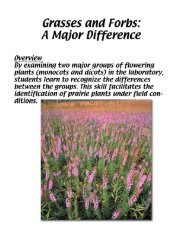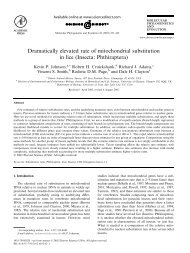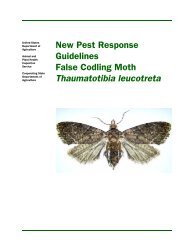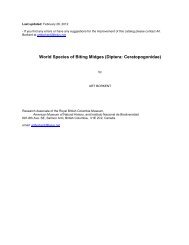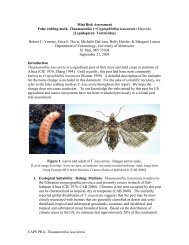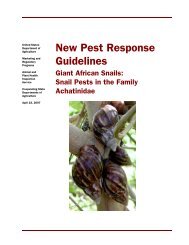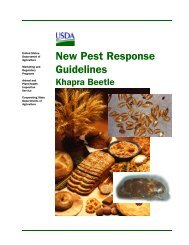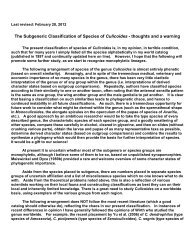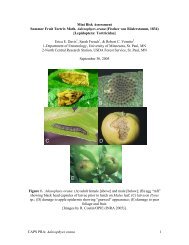(Insecta: Phthiraptera) mitochondrial 12S rRNA secondary structure
(Insecta: Phthiraptera) mitochondrial 12S rRNA secondary structure
(Insecta: Phthiraptera) mitochondrial 12S rRNA secondary structure
- No tags were found...
Create successful ePaper yourself
Turn your PDF publications into a flip-book with our unique Google optimized e-Paper software.
Insect Molecular Biology (2002) 11(4), 361–369Louse (<strong>Insecta</strong>: <strong>Phthiraptera</strong>) <strong>mitochondrial</strong> <strong>12S</strong> <strong>rRNA</strong>Blackwell Science, Ltd<strong>secondary</strong> <strong>structure</strong> is highly variableR. D. M. Page,* R. Cruickshank* and K. P. Johnson†*Division of Environmental and Evolutionary Biology,Institute of Biomedical and Life Sciences, University ofGlasgow, Glasgow, UK; †Illinois Natural History Survey,607 East Peabody Drive, Champaign, IL 61820-6970, USAAbstractLice are ectoparasitic insects hosted by birds andmammals. Mitochondrial <strong>12S</strong> <strong>rRNA</strong> sequencesobtained from lice show considerable length variationand are very difficult to align. We show that the louse<strong>12S</strong> <strong>rRNA</strong> domain III <strong>secondary</strong> <strong>structure</strong> displaysconsiderable variation compared to other insects, inboth the shape and number of stems and loops. Phylogenetictrees constructed from tree edit distancesbetween louse <strong>12S</strong> <strong>rRNA</strong> <strong>structure</strong>s do not closelyresemble trees constructed from sequence data,suggesting that at least some of this structural variationhas arisen independently in different louse lineages.Taken together with previous work on <strong>mitochondrial</strong>gene order and elevated rates of substitution in louse<strong>mitochondrial</strong> sequences, the structural variation inlouse <strong>12S</strong> <strong>rRNA</strong> confirms the highly distinctive natureof molecular evolution in these insects.Keywords: lice, multiple alignment, <strong>rRNA</strong> <strong>secondary</strong><strong>structure</strong>, <strong>12S</strong> <strong>rRNA</strong>, tree comparison metrics.IntroductionCongruent host and parasite phylogenies provide a uniqueframework for comparing rates of molecular evolution intaxonomically distant organisms (Hafner & Nadler, 1990;Moran et al., 1995; Page & Hafner, 1996). By comparingsequence divergence in homologous genes in co-speciatinghosts and their parasites it is possible to determine relativerates of sequence evolution without reference to the fossilrecord. The prevalence of co-speciation between lice andReceived 25 January 2002; accepted after revision 3 May 2002. Correspondence:Dr Roderic D. M. Page, DEEB, IBLS, Graham Kerr Building, Universityof Glasgow, Glasgow G12 8QQ, UK, Tel.: +44 141 330 4778; fax: +44141 330 2972, E-mail: r.page@bio.gla.ac.uktheir hosts has resulted in these insects playing a key rolein recent methodological and empirical (Page, 2002;Paterson & Banks, 2001) studies of relative rates of evolutionin host and parasite assemblages.The large numbers of <strong>mitochondrial</strong> small subunit (<strong>12S</strong>)<strong>rRNA</strong> sequences available for birds (Houde et al., 1997;Mindell et al., 1997) and mammals (Springer & Douzery,1996) makes this gene an attractive candidate for comparingmolecular evolution in lice and their vertebrate hosts.However, the first published louse <strong>12S</strong> <strong>rRNA</strong> sequenceswere described as ‘highly unusual’ (Paterson et al., 2000,p. 390), lacking some highly conserved motifs typical ofanimal <strong>12S</strong> <strong>rRNA</strong> (Hickson et al., 1996), and having large(35–59 base pair) insertions.Faced with highly variable <strong>rRNA</strong> sequences that aredifficult to align using standard methods (e.g. Stoye et al.,1997; Thompson et al., 1997), one approach is to use<strong>secondary</strong> <strong>structure</strong>s to guide the alignment (Buckley et al.,2000; Hickson et al., 1996; Kjer, 1995). However, aligningsequences using their <strong>secondary</strong> <strong>structure</strong> requires aconsiderable manual effort. Concern about the potentialfor subjectivity in such alignments has motivated thedevelopment of automatic tools for generating sequencealignments (e.g. Wheeler, 1994). Indeed, some have arguedthat manual alignments should be avoided altogether(Phillips et al., 2000). However, the main reason manualalignments are needed is that existing algorithms are notup to the task. Automatic methods for aligning primarysequences can fail to align RNA sequences correctly(Hickson et al., 2000), and methods for automaticallyaligning sequences using both primary and <strong>secondary</strong><strong>structure</strong> are in their infancy (Corpet & Michot, 1994;Lenhof et al., 1998; Notredame et al., 1997).We have obtained sequences from domain III of <strong>12S</strong><strong>rRNA</strong> for a wide range of lice, including representativesfrom three of the four suborders of <strong>Phthiraptera</strong>. Withinsmall clades of lice (such as a single genus) the alignmentis usually relatively straightforward. Automatic alignmentmethods such as CLUSTAL (Thompson et al., 1997) andDCA (Stoye et al., 1997) generate clean alignments,in agreement with the results of Hickson et al. (2000).However, applying programs such as CLUSTAL to alllouse sequences together resulted in very poor quality© 2002 The Royal Entomological Society 361
362 R. D. M. Page et al.alignments, especially towards the 3′ end of domain III.We therefore pursued the use of <strong>secondary</strong> <strong>structure</strong> toimprove the alignment. Our preliminary attempts to usepublished <strong>secondary</strong> <strong>structure</strong>s for other animals (includinginsects) met with mixed success, and suggested that somelouse taxa contained large insertions in regions that arehighly conserved in other taxa. Furthermore, some heliceswere not easy to locate in lice, or had different <strong>structure</strong>s.In order to assess the degree of sequence and <strong>structure</strong>variation in insect domain III <strong>12S</strong> <strong>rRNA</strong>, Page (2000b)constructed a <strong>secondary</strong> <strong>structure</strong> model based on an alignmentof 225 insect sequences using maximum weightedmatching (Page, 2000a; Tabaska et al., 1998). In thepresent study we use this model (Fig. 1) as a benchmarkfor determining degree of variation in the <strong>secondary</strong> <strong>structure</strong>in lice. Given that louse <strong>12S</strong> <strong>rRNA</strong> <strong>secondary</strong> <strong>structure</strong>is variable, we investigated whether the variation containsinformation about the evolutionary relationships of lice(rather than being merely a nuisance when constructingalignments).ResultsLouse <strong>secondary</strong> <strong>structure</strong>Secondary <strong>structure</strong>s were inferred for each sequencelisted in Table 1. The key features of these <strong>structure</strong>s aresummarized in Fig. 2. Drawings of <strong>structure</strong> for eachindividual sequence are available online . The inferredFigure 1. Generalized <strong>secondary</strong> <strong>structure</strong> of insect domain III <strong>12S</strong> <strong>rRNA</strong>(from Page, 2000b, fig. 6), showing the location of the <strong>12S</strong>ai and <strong>12S</strong>bi PCRprimers (Simon et al., 1994). The segments used to measure lengthvariation in sequences (Fig. 3) are numbered 1–5. Segment 1 correspondsto the entire <strong>structure</strong> bounded by helix 33.Taxon <strong>12S</strong> <strong>rRNA</strong> COI EF1αAnaticola crassicornis AF396482 AF396541 AF320354Anatoecus spp. AF396485 AF396542 AF320356Ancistrona vagelli AF189128 AF497798 AF320358Ardeicola spp. AF396486 AF396545 AF320361Austrogoniodes watersoni AF189129 AF497799 AF320362Austrophilopterus subsimilis AF189130 AF348874 AF320365Campanulotes compar AF189131 AF348836 AF320377Columbicola baculoides AF190425 AF414764 AF320384Columbicola columbae AF190415 AF278620 AF320385Discocorpus mexicanus AF189133 AF498002 AF320392Docophoroides brevis AF396488 AF396547 AF320394Echinophthirius horridus AF189134 AF498001 AF320396Haffneria grandis AF189135 AF396553 AF320406Halipeurus sp. AF189136 AF396559 AF320408Harrisoniella densa AF396501 AF396567 AF320410Naubates harrisoni AF396504 AF396571 AF320432Oxylipeurus chiniri AF189140 AF348872 AF320436Paraclisis confidens AF396511 AF396579 AF502566Pectenosoma verrucosa AF189141 AF348862 AF320440Pectinopygus brevicornis AF189142 AF497800 AF320442Quadraceps sp. AF396527 AF396599 AF320458Rallicola spp. AF189144 AF348867 AF320459Saemundssonia stresemanni AF189145 AF396612 AF320466Austrogoniodes cristati Y14909 – –Naubates prioni AF396509 – –Table 1. Taxa and sequences used in this study.For each sequence the GENBANK accessionnumber is given. The designation ‘spp.’ indicatesthat the three sequences came from differentspecies, otherwise the same species was used© 2002 The Royal Entomological Society, Insect Molecular Biology, 11, 361–369
Louse <strong>mitochondrial</strong> <strong>12S</strong> <strong>rRNA</strong> <strong>secondary</strong> <strong>structure</strong> 363Figure 2. Secondary <strong>structure</strong>s for domain III for<strong>mitochondrial</strong> <strong>12S</strong> <strong>rRNA</strong> for selected lice species.The complete <strong>structure</strong> for Columbicola columbaeis shown, with regions that vary in other licehighlighted.<strong>secondary</strong> <strong>structure</strong> for domain III <strong>12S</strong> <strong>rRNA</strong> for the pigeonlouse Columbicola columbae (Fig. 2) closely resemblesthat found in most insects (Fig. 1). Compared to the Page(2000b) model, helices 39 and 40 in lice cannot be distinguished,and so are drawn here as a single helix. Of the25 lice sequences we studied, most closely resemble the<strong>structure</strong> for Columbicola. However, some taxa shownotable differences (Fig. 2). Five species in four differentgenera show an additional helix between 36 and 38 that werefer to as helix 37 (following van de Peer et al., 1998). Twotaxa have a much extended helix 42. Inferring <strong>secondary</strong><strong>structure</strong> in the region between helices 34′ and 33′ is noteasy because of difficulties in satisfactorily aligning theirsequences. However, Halipeurus pelagicus and Naubatesharrisoni show clear evidence for an additional stem onthe side of helix 47. Support for this stem comes fromcomparisons with sequences for other species of the genus(Paterson et al., 2000), which show compensating changeswith respect to the sequences presented here.Length variation in insectsFigure 3 shows the variation in sequence length betweensome key landmarks in <strong>12S</strong> <strong>rRNA</strong> domain III. For the 225insect sequences used by Page (2000b), the range oflengths for the sub-sequence starting at helix 33 (segment1 in Fig. 1) is 213–259 bp, with a mean of 225 (SD 5.7).Although most insect sequences are within a narrow 23 bprange of sizes (Fig. 3), there are some notable exceptions.In almost all insects the region between helices 39′ and38′ comprises a 16–27 bp stretch which includes theshort 3–4 bp helix 42. The beetle Caryedon immaculatum(GENBANK accession no. AF004121) and the locust Ruspolianitidula (Z97602) both have large (21–27 bp) insertions inthis region. The cockroaches Nyctibora azteca (U17795)and N. lutzi (U17801) have a 15–20 bp insertion betweenhelices 38′ and 36′, which in other insects is a short 3 or4 bp loop.Length variation in liceFor the 25 sequences in the louse alignment, the lengthbetween the landmarks at the base of helix 33 ranged from205 to 302 bp, with a mean of 235.1 (SD 25.9). While manysequences are of similar length to other insects (Fig. 3),numerous sequences have large insertions in one or moreof three different locations. In lice, the region betweenhelices 36 and 38 comprises anywhere from 4 to 45 basesand appears to form a helix in some taxa (Fig. 2), whereasin other insects this region is a simple bulge of 3–15 bases.The region occupied by helix 42 is variable in lice, and insome Naubates and Austrogonoides species this helixcan be extended from a small three-base helix to a muchlarger <strong>structure</strong> (Fig. 2). The final region of variability spansthe region between helices 34′ and 33′, which in mostinsects shows little length variation (49–58 bp, mean 53,SD 1.9), whereas in lice there may be anything from 33 to78 bases in this region. Most lice fall within the range of© 2002 The Royal Entomological Society, Insect Molecular Biology, 11, 361–369
364 R. D. M. Page et al.Figure 3. Distribution of lengths in base pairs for four regions of <strong>12S</strong> <strong>rRNA</strong> (numbered as in Fig. 1) for 225 insect and 25 louse sequences. Note the greatervariation in lice compared to other insects.other insects (Fig. 3), but lice from the Philoceanus complex(Halipeurus and Naubates) have a 10–20 bp insertion thatcan be folded to form an additional helix (Fig. 2).Structural variationBoth lice and other insects show a wide range of tree editdistances for <strong>12S</strong> <strong>rRNA</strong> <strong>secondary</strong> <strong>structure</strong> (Fig. 4). Forthe 19 exemplar insects, the mean tree edit distance is35.7 (SD 15.8) whereas for the 25 lice it is 46.8 (SD 21.1).Many of the extreme values in Fig. 4 involve the penguinlouse Austrogoniodes cristati, which has a helix 37 and amuch-elongated helix 42 (Fig. 2). After removing this lousesequence, the mean edit distance for louse <strong>structure</strong>sdrops to 41.0 (SD 14.8).Phylogenetic informativenessA comparison between Bayesian trees for louse sequencesand the neighbour-joining tree for RNA <strong>structure</strong>s suggeststhat the <strong>secondary</strong> <strong>structure</strong> contains limited phylogeneticinformation (neighbour-joining trees for the sequence dataare very similar to the Bayesian trees and are not shown).Although the trees for lice based on different genes are alldifferent (Fig. 5, Table 2), they are more similar to each otherthan any are to the <strong>secondary</strong> <strong>structure</strong> tree. Indeed, whetherwe compare the RNA <strong>structure</strong> tree with individual gene trees,non-RNA-based trees, or the tree from all three genes combined,it makes little difference to the comparison. Howeverthe RNA <strong>structure</strong> tree is more similar to the gene trees than© 2002 The Royal Entomological Society, Insect Molecular Biology, 11, 361–369
Louse <strong>mitochondrial</strong> <strong>12S</strong> <strong>rRNA</strong> <strong>secondary</strong> <strong>structure</strong> 365as the grouping of the duck lice Anaticola and Anatoecus,and the petrel lice Halipeurus and Naubates, the latter sharingan extra stem in helix 47 (Fig. 2). However, other groupingsin the RNA <strong>structure</strong> tree, such as Austrogonioides andCampanulotes with Oxylipeurus do not occur in any of thesequence trees. This later grouping reflects the presence ofhelix 37 (Fig. 2), which all three lice share. If there was supportfor this grouping in the sequence data, then we wouldexpect find this group in at least some of the trees sampledfrom the Monte Carlo chain in the Bayesian analysis of thesequence data. Given that none of the 5000 trees sampledcontained a Austrogonioides + Campanulotes + Oxylipeurusclade, we can be confident that there is no evidence fromsequence data for this grouping. Hence, helix 37 has evolvedmore than once in lice and its presence or absence cannotbe used as a reliable phylogenetic marker.DiscussionFigure 4. Distribution of pair-wise tree edit distances between <strong>12S</strong> <strong>rRNA</strong><strong>secondary</strong> <strong>structure</strong>s for 19 insects and 25 lice (Table 1).would expected due to chance, based on the distribution ofpair-wise distances between 1000 random trees (P < 0.001).Inspecting the trees (Fig. 5) shows that there are somesimilarities between the sequence and <strong>structure</strong> trees, suchThe difficulties Paterson et al. (2000) experienced whenaligning louse <strong>12S</strong> <strong>rRNA</strong> are readily understandable.Within Ischnocera there is a considerable variation in bothsequence length and <strong>secondary</strong> <strong>structure</strong>. Indeed, thevariation shown in louse <strong>secondary</strong> <strong>structure</strong>s is greaterthan that depicted by Hickson et al. (1996) in their survey ofanimal <strong>12S</strong> <strong>rRNA</strong> (a quantitative comparison is hamperedbecause of differences between Hickson et al.’s model andthat used here, see Page, 2000b, for details). The variationin length exceeds that found in other insects. When measuredusing tree edit distances, there is as much, if not more,variation within lice than across all insect orders.It would be interesting to see whether the other <strong>mitochondrial</strong>ribosomal gene (16S <strong>rRNA</strong>) shows an increasedstructural variation. To date, the only published 16S <strong>rRNA</strong>sequence from a louse is for the amblyceran Heterodoxusmacropus (Shao et al., 2001). This sequence appearsFigure 5. Trees for the 23 lice in Table 1 constructed by Bayesian analysis of nucleotide sequences (<strong>12S</strong> <strong>rRNA</strong>, and combined EF1α and COI sequences), andneighbour-joining analysis of tree edit distance between <strong>12S</strong> <strong>rRNA</strong> <strong>secondary</strong> <strong>structure</strong>s. Numbers on the internal branches of the sequence trees are theposterior probability values (Huelsenbeck & Ronquist, 2001), where they are greater than 50%.© 2002 The Royal Entomological Society, Insect Molecular Biology, 11, 361–369
366 R. D. M. Page et al.Table 2. Pair-wise distances between trees for lice constructed from<strong>12S</strong> <strong>rRNA</strong>, COI and EF1α sequences (either separately or combined) and from RNA treeedit distances. Lower triangle is the DC measure, upper triangle is SJA (Day, 1986)<strong>12S</strong> <strong>rRNA</strong> + EF1α + COI COI EF1α EF1α + COI <strong>12S</strong> <strong>rRNA</strong> RNA edit distance<strong>12S</strong> <strong>rRNA</strong> + EF1α + COI – 0.218 0.114 0.077 0.290 0.517COI 45 – 0.238 0.238 0.460 0.553Ef1α 53 66 – 0.040 0.392 0.519EF1α + COI 38 52 21 – 0.361 0.507<strong>12S</strong> <strong>rRNA</strong> 124 118 155 157 – 0.616RNA edit distance 476 372 453 476 463 –completely consistent with Buckley et al.’s (2000) model fordomains IV and V of insect 16S <strong>rRNA</strong> <strong>secondary</strong> <strong>structure</strong>,and shows no length variation beyond that found in otherinsects.The diversity of <strong>12S</strong> <strong>rRNA</strong> <strong>structure</strong>s found in lice may besymptomatic of an elevated rate of evolution in louse <strong>mitochondrial</strong>genomes. Studies of the <strong>mitochondrial</strong> proteingenes cytochrome oxidase I (COI) and cytochrome b (cytb) (Hafner et al., 1994; Page et al., 1998) have shown thatthese genes evolve 2–3-fold more rapidly in lice than in theirvertebrate hosts. Page et al. (1998) found that louse cytb showed elevated levels of amino acid replacements withrespect to other insects. The only complete <strong>mitochondrial</strong>genome for a louse sequenced to date (Shao et al., 2001)shows numerous gene rearrangements with respect toother insects, resulting in a gene order unlike any otheranimal. Our own studies have shown that the relative rateof substitution in <strong>mitochondrial</strong> and nuclear genes is anorder of magnitude greater in lice than in other insects(unpublished observations). Taken together, these studiessuggest that lice are indeed highly unusual. It would be veryinteresting to know whether the novel gene order, <strong>rRNA</strong><strong>structure</strong>s and elevated substitution rates in louse mitochondriaall evolved in concert with the lice becomingparasitic, or whether this is specific to particular louse clades.To date, we have only found an RNA structural variationin the Ischnocera; the single amblyceran and anopluransequences available display a typical insect <strong>structure</strong>.The poor match between louse phylogenies based onprimary sequence and <strong>secondary</strong> <strong>structure</strong> suggests thatthe latter is of limited value in inferring louse phylogenies,in contrast to its utility in other organisms (e.g. Billoud et al.,2000; Collins et al., 2000). Although some <strong>structure</strong>s doseem to be correlated with clades, such as the extra stemin helix 47 which is shared by the closely related Halipeurusand Naubates (Fig. 2), some striking features such as helix37 appear to have evolved repeatedly in different clades.The variation in both primary sequence and <strong>secondary</strong><strong>structure</strong> such as those shown by the louse sequencesmakes a multiple sequence alignment difficult. Even if<strong>secondary</strong> <strong>structure</strong> can be inferred with confidence, thealignment of loops (and in some cases stems) can beproblematic. The problem of regions that are difficult toalign has received considerable attention (e.g. Wheeler,1994), with most efforts directed at automated methodsof aligning the primary sequence, which are seen as moreobjective than manual alignment (Phillips et al., 2000).More recently, Wheeler (1999) and Lutzoni et al. (2000)have described an approach which abandons trying tocreate a complete multiple alignment for all sequences. Fixedstateoptimization treats strings of nucleotides as characterstates. The cost of transformation between these states isan edit cost (the number of operations required to transformone sequence into another). Although in existing implementationsthe edit costs are based on primary <strong>structure</strong>,the approach could be generalized to include measuresof <strong>secondary</strong> <strong>structure</strong> difference (Hofacker et al., 1994;Moulton et al., 2000). Hence, rather than opposing automaticmethods such as optimization alignment and fixedstateoptimization with <strong>secondary</strong> <strong>structure</strong> alignment,these approaches might be usefully merged into a singleautomated method for aligning variable RNA sequences.Experimental proceduresSequencesTotal genomic DNA was extracted from single lice using the DNAeasyTissue Kit (Qiagen). The third domain of the <strong>12S</strong> <strong>rRNA</strong> gene wasamplified and sequenced using the insect specific primers<strong>12S</strong>ai and <strong>12S</strong>bi (Simon et al., 1994). Amplification products weregel purified using the QIAquick Gel Extraction Kit (Qiagen) or theQiagen PCR Purification Kit, and sequenced using the ABI PRISMDye Terminator Cycle Sequencing Ready Reaction Kit withAmpliTaq DNA polymerase, FS (Perkin Elmer). The sequencingproducts were ethanol precipitated and run on an ABI 373 or 377Stretch automated sequencing machine. Previously published<strong>12S</strong> <strong>rRNA</strong> for seabird lice (Paterson et al., 2000) were retrievedfrom GENBANK. The sequences used in this study are listed inTable 1, and (with the exception of Austrogoniodes cristati andNaubates prioni) represent those <strong>12S</strong> <strong>rRNA</strong> sequences for whichEF1α and COI sequences are also available (Cruickshank et al.,2001; Johnson & Clayton, 2002; Johnson et al., 2001a,b, 2002).Insect <strong>12S</strong> <strong>rRNA</strong> <strong>secondary</strong> <strong>structure</strong>We used as our point of reference the 225 insect <strong>12S</strong> <strong>rRNA</strong>sequence alignment employed by Page (2000b) to infer ageneral model of insect <strong>12S</strong> <strong>rRNA</strong> <strong>secondary</strong> <strong>structure</strong> (thisalignment is available from the EMBL WEBALIGN database© 2002 The Royal Entomological Society, Insect Molecular Biology, 11, 361–369
Louse <strong>mitochondrial</strong> <strong>12S</strong> <strong>rRNA</strong> <strong>secondary</strong> <strong>structure</strong> 367 as alignmentDS43718). The original alignment was constructed usingCLUSTALX (Thompson et al., 1997) without reference to <strong>secondary</strong><strong>structure</strong>, and contained some regions that – in light of the resulting<strong>secondary</strong> <strong>structure</strong> model – are obviously misaligned. In thepresent study we manually edited regions of poor quality (Page,2000b, fig. 7) in the 225 sequence alignment to improve the fit tothe <strong>secondary</strong> <strong>structure</strong> model.Length variationAs a simple measure of <strong>secondary</strong> <strong>structure</strong> conservation, wecounted the number of bases (ignoring gaps) between key ‘landmarks’in the <strong>secondary</strong> <strong>structure</strong> model, such as the start and endof helix 33 (Fig. 1). Variation in length amongst different specieswill reflect insertion and deletion events, and varying lengths ofstems and loops. We measured length variation for the 225 insectsequences, and the louse sequences. For some of the 225 insectsequences there is uncertainty about the <strong>secondary</strong> <strong>structure</strong> ofthe more variable helices (such as 39, 40, 42 and 47), hence theselandmarks were located on the core conserved helices whose<strong>structure</strong> has been firmly established.Quantifying <strong>secondary</strong> <strong>structure</strong> differencesTo quantify the difference between <strong>secondary</strong> <strong>structure</strong>s we usedthe RNADISTANCE program in the Vienna RNA package (Hofackeret al., 1994). This program computes a tree edit distance, d T ,between two RNA <strong>structure</strong>s. This measure counts the minimumnumber of insertions and deletions of paired and unpaired basesneeded to transform one RNA <strong>structure</strong> into another (Fontanaet al., 1993; Moulton et al., 2000). Although the louse <strong>12S</strong> <strong>rRNA</strong>sequences were all obtained with the same primers, our ability toread the 5′ and 3′ ends of the sequences varied among taxa.Hence, when computing edit distances the sequences werepruned to include only the <strong>structure</strong> rooted at helix 33 (segment 1in Fig. 1). To assess the variation among major insects groups, weused a subset of 15 sequences for which we were confident in the<strong>secondary</strong> <strong>structure</strong> of both the core helices and the more variableregions. We also added four taxa with the most divergent <strong>secondary</strong><strong>structure</strong>s to ensure that the full range of variation in insect<strong>structure</strong>s was represented. The taxa and sequences used arethe dipterans Drosophila yakuba (X03240), Diplonevra nitidula(AF126298), and Anopheles gambiae (L20934); the butterflyAglais urticae (AF232882); the honey bee Apis mellifera (L06178);the beetles Tachinus luridus (AF021047), Caryedon acaciae(AF004114), Caryedon immaculatum (AF004121), Molops piceus(AF190021); the bugs Panstrongylus megistus (AF021178) andDalbulus charlesi (AF051276); the cicada Magicicada cassini(X97149); the cockroaches Archimandrita tessellata (U17762)and Nyctibora azteca (U17795); the termite Hodotermopsisjaponica (AB006580); the grasshoppers Gomphocerippus rufus(Z93247) and Ruspolia nitidula (Z97602); the damselfly Ischnurabarberi (AF067703), and the silverfish Ctenolepisma longicaudata(L02381).Louse <strong>secondary</strong> <strong>structure</strong>Initial <strong>secondary</strong> <strong>structure</strong>s were computed using the programRNALIGN (Corpet & Michot, 1994; ftp://ftp.toulouse.inra.fr/pub/rnalign/). This program takes a sequence and aligns it to a referencealignment and <strong>secondary</strong> <strong>structure</strong> model using both primaryand <strong>secondary</strong> <strong>structure</strong> simultaneously. Page (2000b) constructeda server that aligns a user-supplied sequence to a reference alignmentof five insect sequences and the Page (2000b) <strong>secondary</strong><strong>structure</strong>. The server returns a <strong>secondary</strong> <strong>structure</strong> for the user’ssequence, and an alignment of that sequence to the five referencesequences.Where necessary, we adjusted the louse alignments and<strong>structure</strong>s found by RNAlign, either manually or using CLUSTALW,taking in to account evidence for compensating mutations(Gutell et al., 1992). In cases where there were large insertionsrelative to the general insect model, possible <strong>secondary</strong> <strong>structure</strong>sfor these insertions were obtained using thermal folding as implementedin the program RNADRAW (Matzura & Wennborg, 1996).This technique can be used to suggest <strong>secondary</strong> <strong>structure</strong>s, butis not as reliable as comparative techniques (Konings & Gutell,1995). Secondary <strong>structure</strong>s were drawn using RNAVIZ 1.0 (de Rijk& de Wachter, 1997).Phylogenetic tree construction and comparisonHigher level louse phylogeny is currently uncertain (Cruickshanket al., 2001; Johnson & Whiting, 2002), so we constructed trees forthe 23 of the 25 louse taxa in Table 1 for which we have sequencesfrom the <strong>12S</strong> <strong>rRNA</strong>, elongation factor 1α (EF1α), and <strong>mitochondrial</strong>cytochrome oxidase I (COI) genes. Trees were computedseparately for each gene, all three genes combined, and for justthe EF1α and COI sequences (to ensure complete independencefrom the <strong>12S</strong> <strong>rRNA</strong> sequences). Bayesian analysis was performedusing MRBAYES (Huelsenbeck & Ronquist, 2001) with the followingsettings. The maximum likelihood model employed six substitutiontypes (‘nst = 6’), with base frequencies set to the empiricallyobserved values (‘basefreq = empirical’). Rate variation acrosssites was modelled using a gamma distribution, with a proportionof sites being invariant (‘rates = invgamma’). The Markov chainMonte Carlo search was run with four chains for 500 000 generations,with trees being sampled every 100 generations (the first1000 trees were discarded as ‘burnin’). Support for individualgroups of taxa was determined by finding the frequency of thatgroup in the set of trees sampled from the Monte Carlo chain. Thisis the posterior probability or ‘credibility’ of that group. Neighbourjoiningtrees were also computed from LOGDET (Lockhart et al.,1994) sequence distances using in PAUP* (Swofford, 2001).A tree of RNA <strong>secondary</strong> <strong>structure</strong>s was constructed from treeedit distances (see above) using neighbour joining. The similaritybetween the sequence and <strong>structure</strong> trees was computed usingtriplet tree comparison metrics (Critchlow et al., 1996; Day, 1986).Given a pair of trees, these measures break the two trees up intoall possible sets of rooted trees (‘triplets’). There is a family of treedistance measures based on counting how many triplets areresolved in each tree, and whether they are resolved the sameway. For each pair of trees, two measures were computed: DC, thenumber of resolved triplets which are different in the two trees; andSJA, the number of strict joint assertions, which is DC normalizedby dividing by the number of triplets resolved in the two trees.These measures are the rooted equivalents of the measures forquartets described by Day (1986).The value of SJA ranges from 0(trees have no triplets in common) to 1 (all triplets are identical).Null distributions for these measures were obtained by computing thedistances between 1000 pairs of random trees using COMPONENT(Page, 1993).© 2002 The Royal Entomological Society, Insect Molecular Biology, 11, 361–369
368 R. D. M. Page et al.Electronic availability of dataThe sequences in Table 1 are available in GENBANK. The alignmentsused to infer the <strong>secondary</strong> <strong>structure</strong>s are available from.AcknowledgementsThis work was supported by NERC grant GR3/11075 toR.D.M.P., Richard Griffiths, and Robert Furness, and by anNSF-CAREER award DEB-9703003 to Dale H. Clayton.We thank the Wolfson Foundation, and the University ofUtah DNA Sequencing Facility, supported in part by NCIgrant #5p30CA42014. D. H. Clayton, D. Drown, R. Furness,A. Paterson and P. Thompson provided assistance incollecting louse specimens. Florence Corpet provided helpwith RNALIGN. For comments on various versions of themanuscript we thank Martyn Kennedy, Vince Smith and twoanonymous referees.ReferencesBilloud, B., Guerrucci, M.-A., Masselot, M. and Deutsch, J.S.(2000) Cirripede phylogeny using a novel approach: molecularmorphometrics. Mol Biol Evol 17: 1435–1445.Buckley, T.R., Simon, C., Flook, P.K. and Misof, B. (2000)Secondary <strong>structure</strong> and conserved motifs of the frequentlysequenced domians IV and V of the insect <strong>mitochondrial</strong> largesubunit <strong>rRNA</strong> gene. Insect Mol Biol 9: 565–580.Collins, L.J., Moulton, V. and Penny, D. (2000) Use of RNA <strong>secondary</strong><strong>structure</strong> for studying the evolution of RNase P and RNaseMRP. J Mol Evol 51: 194–204.Corpet, F. and Michot, B. (1994) RNAlign program: alignment ofRNA sequences using both primary and <strong>secondary</strong> <strong>structure</strong>s.CABIOS 10: 389–399.Critchlow, D.E., Pearl, D.K. and Qian, C. (1996) The triples distancefor rooted bifurcating phylogenetic trees. Syst Biol 45: 323–334.Cruickshank, R.H., Johnson, K.P., Smith, V.S., Adams, R.J.,Clayton, D.H. and Page, R.D.M. (2001) Phylogenetic analysisof elongation factor 1α identifies major groups of lice (<strong>Insecta</strong>:<strong>Phthiraptera</strong>). Mol Phylog Evol 19: 202–215.Day, W.H.E. (1986) Analysis of quartet dissimilarity measuresbetween undirected phylogenetic trees. Syst Zool 35: 325–333.Fontana, W., Konings, D.A.M., Stadler, P.F. and Schuster, P. (1993)Statistics of RNA <strong>secondary</strong> <strong>structure</strong>s. Biopolymers 33:1389–1404.Gutell, R.R., Power, A., Hertz, G.Z., Putz, E.J. and Stormo, G.D.(1992) Identifying constraints on the higher-order <strong>structure</strong> ofRNA: continued development and application of comparativesequence analysis methods. Nucl Acids Res 20: 5785–5795.Hafner, M.S. and Nadler, S.A. (1990) Cospeciation in hostparasiteassemblages: Comparative analysis of rates ofevolution and timing of cospeciation. Syst Zool 39: 192–204.Hafner, M.S., Sudman, P.D., Villablanca, F.X., Spradling, T.A.,Demastes, J.W. and Nadler, S.A. (1994) Disparate rates ofmolecular evolution in cospeciating hosts and parasites.Science 265: 1087–1090.Hickson, R.E., Simon, C., Cooper, A., Spicer, G.S., Sullivan, J. andPenny, D. (1996) Conserved sequence motifs, alignment, and<strong>secondary</strong> <strong>structure</strong> for the third domain of animal <strong>12S</strong> <strong>rRNA</strong>.Mol Biol Evol 13: 150–169.Hickson, R.E., Simon, C. and Perrey, S.W. (2000) The performanceof several multiple-sequence alignment programs in relation to<strong>secondary</strong>-<strong>structure</strong> features for an <strong>rRNA</strong> sequence. Mol BiolEvol 17: 530–539.Hofacker, I.L., Fontana, W., Stadler, P.F., Bonhoeffer, L.S., Tacker, M.and Schuster, P. (1994) Fast folding and comparison of RNA<strong>secondary</strong> <strong>structure</strong>s. Monatsh Chem 125: 167–188.Houde, P., Cooper, A., Leslie, E., Strand, A.E. and Montaño, G.A.(1997) Phylogeny and evolution of <strong>12S</strong> rDNA in Gruiformes(Aves). In Avian Molecular Evolution and Systematics(Mindell, D.P., ed.), pp. 121–158. Academic Press, San Diego.Huelsenbeck, J.P. and Ronquist, F. (2001) MRBAYES: Bayesianinference of phylogenetic trees. Bioinformatics 17: 754–755.Johnson, K.P., Adams, R.J. and Clayton, D.H. (2001a) Molecularsystematics of the Goniodidae (<strong>Insecta</strong>: <strong>Phthiraptera</strong>). J Parasitol87: 862–869.Johnson, K.P. and Clayton, D.H. (2002) Coevolutionary history ofecological replicates: comparing phylogenies of wing andbody lice to Columbiform hosts. In Tangled Trees: Phylogeny,Cospeciation and Coevolution (Page, R.D.M., ed.). Universityof Chicago Press, Chicago.Johnson, K.P., Moyle, R.G., Witt, C.C., Faucett, R.C. andWeckstein, J.D. (2001b) Phylogenetic relationships in the lousegenus Penenirmus based on nuclear (EF-1α) and <strong>mitochondrial</strong>(COI) DNA sequences. Syst Entomol 26: 491–497.Johnson, K.P. and Whiting, M.F. (2002) Multiple genes and themonophyly of Ischnocera (<strong>Insecta</strong>: <strong>Phthiraptera</strong>). Mol PhylogEvol 22: 101–110.Johnson, K.P., Williams, B.L., Drown, D.M., Adams, R.J. andClayton, D.H. (2002) The population genetics of host specificity:genetic differentiation in dove lice. Mol Ecol 11: 25–38.Kjer, K.M. (1995) Use of <strong>rRNA</strong> <strong>secondary</strong> <strong>structure</strong> in phylogeneticstudies to identify homologous positions: an example of alignmentand data presentation from the frogs. Mol Phylog Evol 4:314–330.Konings, D.A.M. and Gutell, R.R. (1995) A comparison of thermodynamicfoldings with comparatively derived <strong>structure</strong>s of 16Sand 16S-like <strong>rRNA</strong>s. RNA 1: 559–574.Lenhof, H.-P., Reinert, K. and Vingron, M. (1998) A polyhedralapproach to RNA sequence <strong>structure</strong> alignment. J Comput Biol5: 517–530.Lockhart, P.J., Steel, M.A., Hendy, M.D. and Penny, D. (1994)Recovering evolutionary trees under a more realistic model ofsequence evolution. Mol Biol Evol 11: 605–612.Lutzoni, F., Wagner, P., Reeb, V. and Zoller, S. (2000) Integratingambiguously aligned regions of DNA sequences in phylogeneticanalyses without violating position homology. Syst Biol49: 628–651.Matzura, O. and Wennborg, A. (1996) Rnadraw: an IntegratedProgram for RNA Secondary Structure Calculation and AnalysisUnder 32-Bit Microsoft Windows. CABIOS. 12, 247–249.Mindell, D.P., Sorenson, M.D., Huddleston, C.J., Miranda, H.C.,Knight, A., Sawchuck, S.J. and Yuri, T. (1997) Phylogeneticrelationships among and within select avian orders based on<strong>mitochondrial</strong> DNA. In Avian Molecular Evolution and Systematics(Mindell, D.P., ed.), pp. 213–247. Academic Press, SanDiego.© 2002 The Royal Entomological Society, Insect Molecular Biology, 11, 361–369
Louse <strong>mitochondrial</strong> <strong>12S</strong> <strong>rRNA</strong> <strong>secondary</strong> <strong>structure</strong> 369Moran, N.A., van Dohlen, C.D. and Baumann, P. (1995) Fasterevolutionary rates in endosymbiotic bacteria than in cospeciatinginsect hosts. J Mol Evol 41: 727–731.Moulton, V., Zuker, M., Steel, M., Pointon, R. and Penny, D.(2000) Metrics on RNA <strong>secondary</strong> <strong>structure</strong>s. J Comput Biol 7:277–292.Notredame, C., O’Brien, E.A. and Higgins, D.G. (1997) RAGA:RNA sequence alignment by genetic algorithm. Nucl Acids Res25: 4570–4580.Page, R.D.M. (1993) COMPONENT, Tree Comparison Software forMicrosoft® Windows. The Natural History Museum, London.Page, R.D.M. (2000a) Circles: automating the comparative analysisof RNA <strong>secondary</strong> <strong>structure</strong>. Bioinformatics 16: 1042–1043.Page, R.D.M. (2000b) Comparative analysis of <strong>secondary</strong> <strong>structure</strong>of insect <strong>mitochondrial</strong> small subunit ribosomal RNA usingmaximum weighted matching. Nucl Acids Res 28: 3839–3845.Page, R.D.M., ed. (2002) Tangled Trees: Phylogeny, Cospeciationand Coevolution. University of Chicago Press, Chicago.Page, R.D.M. and Hafner, M.S. (1996) Molecular phylogenies andhost-parasite cospeciation: gophers and lice as a modelsystem. In: New Uses for New Phylogenies (Harvey, P.H.,Leigh Brown, A.J., Maynard Smith, J. and Nee, S., eds),pp. 255–270. Oxford University Press, Oxford.Page, R.D.M., Lee, P.L.M., Becher, S.A., Griffiths, R. andClayton, D.H. (1998) A different tempo of <strong>mitochondrial</strong> DNAevolution in birds and their parasitic lice. Mol Phylog Evol 9:276–293.Paterson, A.M. and Banks, J. (2001) Analytical approaches tomeasuring cospeciation of host and parasites: through a glass,darkly. Int J Parasitol 31: 1012–1022.Paterson, A.M., Wallis, G.P., Wallis, L.J. and Gray, R.D. (2000)Seabird and louse coevolution: complex histories revealed by<strong>12S</strong> <strong>rRNA</strong> sequences and reconciliation analysis. Syst Biol 49:383–399.van de Peer, Y., Caers, A., de Rijk, P. and de Wachter, R. (1998)Database on the <strong>structure</strong> of small ribosomal subunit RNA.Nucl Acids Res 26: 179–182.Phillips, A., Janies, D. and Wheeler, W. (2000) Multiple sequencealignment in phylogenetics. Mol Phylog Evol 16: 317–330.de Rijk, P. and de Wachter, R. (1997) RnaViz, a program for thevisualisation of RNA <strong>secondary</strong> <strong>structure</strong>. Nucl Acids Res 25:4679–4684.Shao, R., Campbell, N.J.H. and Barker, S.C. (2001) Numerousgene rearrangements in the <strong>mitochondrial</strong> genome of thewallaby louse, Heterodoxus macropus (<strong>Phthiraptera</strong>). Mol BiolEvol 18: 858–865.Simon, C., Frati, F., Beckenbach, A., Crespi, B., Liu, H. andFlook, P. (1994) Evolution, weighting, and phylogenetic utility of<strong>mitochondrial</strong> gene sequences and a compilation of conservedpolymerase chain reaction primers. Ann Entomol Soc Am 87:651–704.Springer, M.S. and Douzery, E. (1996) Secondary <strong>structure</strong> andpatterns of evolution among mammalian <strong>mitochondrial</strong> <strong>12S</strong><strong>rRNA</strong> molecules. J Mol Evol 43: 357–373.Stoye, J., Moulton, V. and Dress, A.W.M. (1997) DCA: an efficientimplementation of the Divide-and-Conquer multiple sequencealignment algorithm. CABIOS 13: 625–626.Swofford, D.L. (2001) PAUP*. Phylogenetic Analysis Using Parsimony(*and Other Methods), Version 4. Sinauer Associates,Sunderland, MA.Tabaska, J.E., Cary, R.E., Gabow, H.N. and Stormo, G.D. (1998)An RNA folding method capable of identifying pseudoknotsand base triples. Bioinformatics 14: 691–699.Thompson, J.D., Gibson, T.J., Plewniak, F., Jeanmougin, F. andHiggins, D.G. (1997) The ClustalX windows interface: flexiblestrategies for multiple sequence alignment aided by qualityanalysis tools. Nucl Acids Res 25: 4876–4882.Wheeler, W.C. (1994) Sources of ambiguity in nucleic acidsequence alignment. In: Molecular Ecology and Evolution:Approaches and Applications (Schierwater, B., Striet, B.,Wagner, G.P. and DeSalle, R., eds), pp. 323–352. Birkhäuser-Verlag, Basel.Wheeler, W. (1999) Fixed character states and the optimization ofmolecular sequence data. Cladistics 15: 379–385.© 2002 The Royal Entomological Society, Insect Molecular Biology, 11, 361–369



